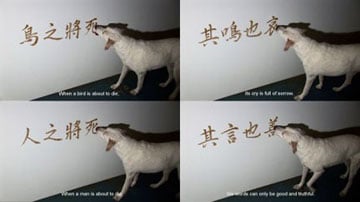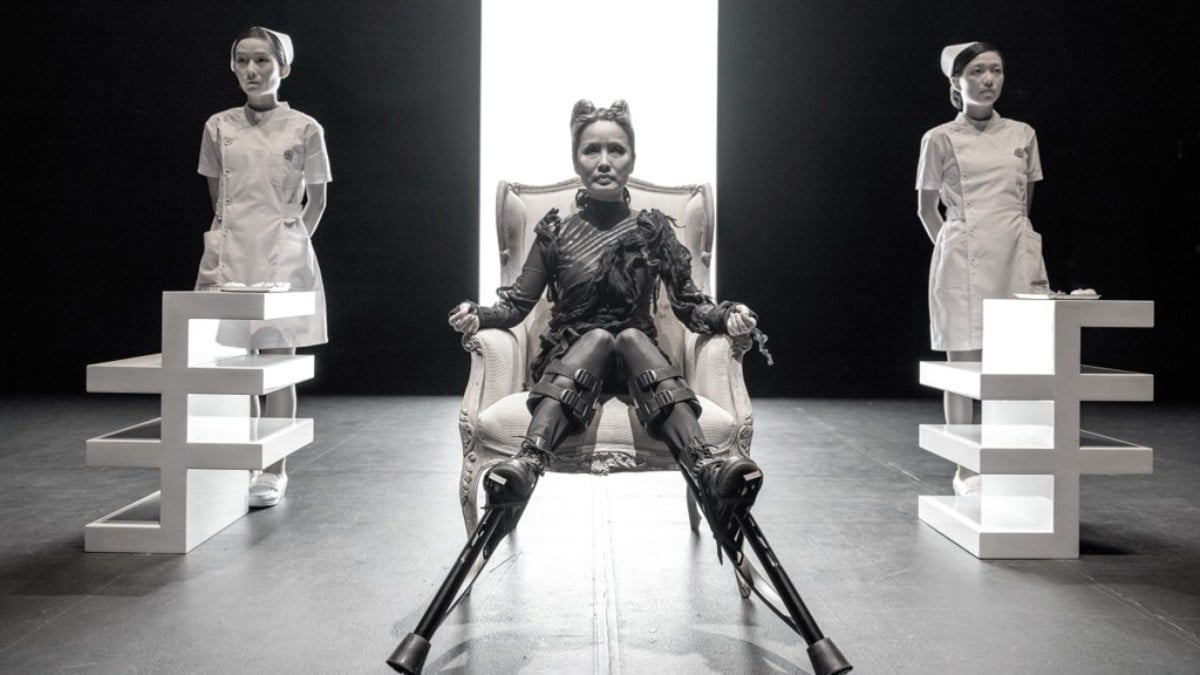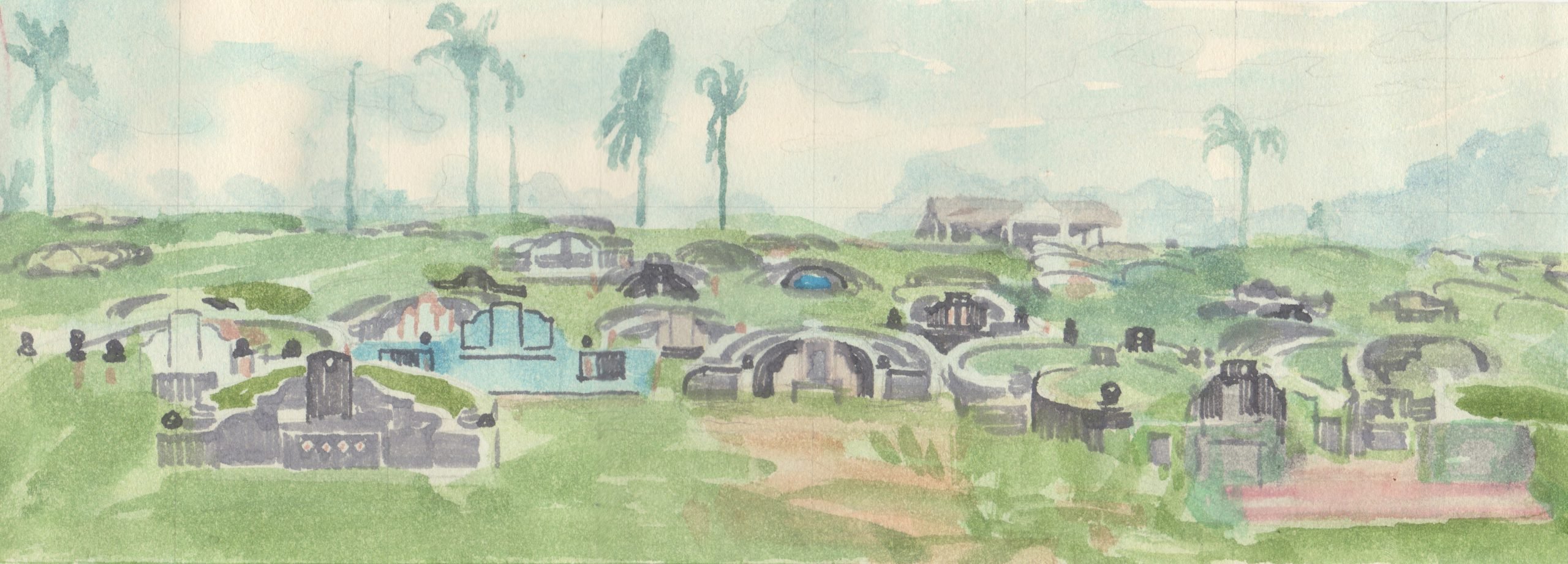
© » KADIST
Mimian Hsu Chen
In Hsu’s work, Colonia China (2014), the artist documents a Chinese cemetery of Costa Rica’s Limón Province, along the country’s Caribbean coast. Serving as the final resting place for Chinese migrants who came to Coast Rica during the late nineteenth century as indentured laborers working to construct the Transatlantic Railroad, the Colonia China speaks to a long but divided history. Hsu’s photographs of the burial ground also echo her interest in typography, with blocky black lettering and painted Chinese characters marking the cemetery as a space belonging to two different worlds.

© » KADIST
Chen Shaoxiong
After engaging primarily with video and photography for more than a decade, Chen turned to painting to explore the issue of urban change and memories—both personal and collective. This “return to origin” reveals an interesting critical reflection on the interactive relation between outside change and internal reflection, and the possibility for more experimental approaches that revive “traditional media.” Chen’s series Collective Memories depicts some of the most important architectural works and urban sites in modern Chinese society, especially those related to the history of revolutions. Instead of reproducing the images himself, Chen invited the public to participate in their making by using their fingers to paint directly on the paper or canvas.

© » KADIST
Chen Zhexiang
In the video work Any Resemblance is Coincidental , CHEN Zhexiang mined portraits of real Asian criminals that were abandoned on the Internet. In order to form a database of the portraits, he saved the files under the original names retrieved from the Internet. CHEN used digital facial recognition technology to build a lexicon of the criminals’ facial characteristics in order to analyze them.

© » KADIST
Xiaoyun Chen
In the video work Drag, a man in a dark room pulls on the end of a rope. In midst of sounds of heavy breathing, the camera presents alternating scenes of a man and the shadow of a man wearing a long, pointed hat cast against a wall. Insinuating a sinister mood, the man and the shadow struggle to control the scene through alternating tugs and releases of a rope.

© » KADIST
Chen Shaoxiong
After engaging primarily with video and photography for more than a decade, Chen turned to painting to explore the issue of urban change and memories—both personal and collective. This “return to origin” reveals an interesting critical reflection on the interactive relation between outside change and internal reflection, and the possibility for more experimental approaches that revive “traditional media.” For Ink Diary , Chen recorded his daily life and impressions within a rapidly-changing urban setting in ink wash paintings which he then turned into an animated film. The complex result of this simple process is both highly innovative and reflective of modernization.

© » KADIST
Chia-Wei Hsu
Stones and Elephants by Chia-Wei Hsu derives from the Malay literary classic The Hikayat Abdullah . The author Abdullah bin Abdul Kadir, who once served as the secretary of Major General William Farquhar, chronicled his life in Malaysia and published his writings in 1849. Hsu’s video installation excerpts two chap- ters from this classic.

© » KADIST
Chia-Wei Hsu
Marshal Tie Jia (Turtle Island) explores the history of a tiny island off of the coast of Matsu in the Taiwan Strait that has been instrumental in the geopolitical relationships between China, Taiwan, and Japan. The Chinese frog deity, Marshal Tie Jia, is now exiled to the island where he is still revered by the Taiwanese people. The installation includes documentation of the artist’s correspondence with the frog deity placed upon an altar, while the video explores both Marshal’s birthplace in China and his current home on Turtle Island.

© » KADIST
Chia-Wei Hsu
The final work in the Marshal Tie Jia series (of which Turtle Island is in the KADIST collection), Spirit Writing features the Marshal in conversation with Chia-Wei Hsu, by way of a ritual involving the Marshal’s divination chair. Marshal Tie Jia is a frog god, who was born in a pond in Jiangxi, China, before fleeing to Matsu Island off the coast of Taiwan during the Cultural Revolution after his temple was destroyed. Spirit Writing attempts to reconstruct the original temple using 3D modeling software, operated in real time as Hsu asks the Marshal questions, receiving answers through a divination ritual in which the chair is swung violently around by his acolytes.

© » KADIST
Chia-Wei Hsu
The word Takasago alludes to several things at once. Takasago is the name of a multi-billion dollar Japanese corporation, previously situated in Taiwan pre-World War II. It is also a famous Japanese Noh play, the oldest extant form of performance in Japan, combining dance, costuming/masks, acting, and operatic chants.

© » KADIST
Vivian Suter
Vivian Suter paints her canvases and then allows them to come in contact with natural elements. For thirty years she has lived in isolation in the Guatemalan jungle, accumulating canvases, sometimes leaving them out for long periods of time. As a result, Suter does not title or date her paintings.

© » KADIST
Xiaoyun Chen
The central point of Vanishing Point is the most direct physiological reaction of the body to the environment. Chen Xiaoyun has added a written narrative and a poetic quality to his works. Image fragments containing different pieces of information are linked together by the text, their interplay producing a synesthesia effect.

© » KADIST
Xiaoyun Chen
The image of rusted nails, nuts and bolts as shrapnel sandwiched between a fried Chicken burger highlights the contrast between decadence and destruction. Chen emphasizes the direct sensational impact of his work to allow his viewer to question the boundary between reality and art. The image of nails as food harks at a visceral relationship with the title, which cries the tone of a manifesto.

© » KADIST
Xiaoyun Chen
The lengthy titles in Chen Xiaoyun’s work often appear as colophons to his photographs that invite the viewer to a process of self realization through contemplating the distance between word and image. Near his studio, Chen often walks over fallen branches in late autumn and sense their existence. Thus, his placing them in diverse contexts builds a “narrative Ariadne’s thread” where the branches become “the language of things” intertextually cohering his oeuvre.

© » KADIST
Xiaoyun Chen
State Terrorism in the ultimate form of Pre-Raphaelite Brotherhood features a portrait of the artist wearing a zipped utilitarian jacket reminiscent of a worker’s uniform, with one arm behind his back as if forced to ingest a bundle of stick—a literal portrayal to the definition of fascism. The title alludes to the Pre-Raphaelite notion of a brotherhood based on “truth to nature.” Censorship of the mouth and indigestion of freshly cut stalks, central to Chen’s language of tree branches, feeds back provocatively to the title’s suggestion of “state terrorism.” However, one must resist seeking symbolic meaning in the image as Chen’s focus is on the direct visual impact of the absurd act portrayed.

© » KADIST
Cao Shu
The installation Infinity and Infinity Plus One by Cao Shu is a modern fable of destruction, collective consciousness, and future memory told through the lens of a seaside hotel erected in the 1990s on an island in China. Combining 3D-rendered images and shot footage, the work travels through a seemingly-unlimited number of rooms, infinite corridors, and breathtaking viewpoints on site. Meanwhile, an official voiceover tells an absurd story about philosophy and mathematics in the form of a monologue.

© » KADIST
Imran Qureshi
At first glance, This Day by Imran Qureshi appears to be an energetic, gestural painting reminiscent of Action Painting from the mid-20th century. But upon closer inspection, highly detailed floral elements reveal themselves amongst the bold red brushstrokes. The botanical motifs in Qureshi’s work represent life and regeneration while the red paint refers to death and mortality.

© » KADIST
Minia Biabiany
Musa is a visual and textual work by Minia Biabiany and the starting point of a broader research around the sexuality of Caribbean women, the historical legacy of slavery, and the artist’s own female lineage. Sometimes shown within an installation, sometimes on its own, the video combines images of flowers, landscapes, and bodies, with text in Creole and English. The video is conceived as a weaving, its technique creating stitchings and surfaces, upon which the artist inscribes stories.

© » KADIST
I-Hsuen Chen
Drawing & Print (Drawing & Print)
Part of the series Still Life Analysis II: The Island , the two photographs The Objects under the Civic Boulevard and A Yellow Blanket on a Wooden Pallet feature household objects of vagrants living beneath the Taipei’s Civic Boulevard expressway. Such objects include trash, unidentified discarded objects, and plants. For the artist, the underside of Civic Boulevard resembles a subtropical island with its artificial stones and potted plants decor.

© » KADIST
Yin-Ju Chen
Drawing & Print (Drawing & Print)
This work includes sketches for Extrastellar Evaluations , the project she produced at Kadist. Extrastellar Evaluations introduces Plato’s mythical state of Atlantis as the theoretical birthplace of conceptual art. Well-known and obscure epistemological notions from the annals of cosmology and mysticism guided and informed her research in the Bay Area during the Kadist residency at the beginning of 2016.

© » KADIST
Shen Yuan
Through a seemingly haphazard layering of glass and porcelain, Dérive is part of a larger installation series that address borders and displacement. Sheets of glass and porcelain, two transformational materials of alchemy, are stacked loosely in the shape of melting glaciers that places humans, animals, and nature in the same ecosystem. Migrations of one population into another and the subsequent displacement is emphasized in sharp, jagged edges of the transparent glass—phantasmagoric dreams of a distant place—the migration of not simply physical bodies but also that of political opinions and thoughts.

© » KADIST
Leelee Chan
Blindfold Receptor (caterpillar-yellow) by Leelee Chan is inspired by the camouflaging nature of the peppered-moth caterpillar. In 1800s Europe, during the industrial revolution, light-colored moths evolved into a darker color after trees in their habitat darkened by the polluting soot. Today, due to rapid human changes to the environment, caterpillars can adapt even before they metamorphose into moths, mimicking the colour of the branches they inhabit.

© » KADIST
Ian Cheng
Ian Cheng’s project 3FACE is based on a model that is derived from both the artist’s extensive readings on psychology and cognition, and his own intuitive understanding of how people function. 3FACE positions the process of minting a generative NFT as a metaphor for personality development. While part of a series, because of the responsive coding, each NFT is unique and is informed by the contents of the owner’s wallet.

© » KADIST
Ian Cheng
Ian Cheng’s project 3FACE is based on a model that is derived from both the artist’s extensive readings on psychology and cognition, and his own intuitive understanding of how people function. 3FACE positions the process of minting a generative NFT as a metaphor for personality development. While part of a series, because of the responsive coding, each NFT is unique and is informed by the contents of the owner’s wallet.

© » KADIST
Kent Chan
Heat Waves by Kent Chan examines the contexts, politics, and proliferation of the different aesthetics of heat by drawing from the aesthetics of regions defined by hot and humid climates and associated with histories of coloniality such as ‘the global south’ and the ‘developing world’. The video takes the form of a curated broadcast or music video of historical and contemporary imagery and videos of both found and filmed footage, including media broadcasts; TikToks; DJ sets; an interview with Keanu Reeves; an excerpt of Ho Tzu Nyen’s 4 x 4 – Episodes of Singapore Art (2005); an interview with KADIST Collection artist Julian Abraham Togar; and DJ sets. The barrage of footage weaves together contrasting tropes about the tropics: depicting it as a diseased paradise; naturally abundant, yet economically poor; filled with people who are at once energetic and lazy; with dynamic aesthetics, but lacking order.

© » KADIST
Troy Chew
Too Many Names by Troy Chew is a patchwork of contemporary Black culture and resistance, including hand-sewn symbols and patterns found in the coats of arms of the kings of the Dahomey region (now Benin) that ruled from 1600-1900. This painting is part of the series Out the Mud, a longterm project in which the artist explores African American history through the lens of traditional mudcloth techniques found in the West African countries involved in the Transatlantic-slave trade. The title of the series references the technique and materials for making mudcloth.

© » KADIST
Ian Cheng
Ian Cheng’s project 3FACE is based on a model that is derived from both the artist’s extensive readings on psychology and cognition, and his own intuitive understanding of how people function. 3FACE positions the process of minting a generative NFT as a metaphor for personality development. While part of a series, because of the responsive coding, each NFT is unique and is informed by the contents of the owner’s wallet.

© » KADIST
Ruijun Shen
In Seven Deadly Sins (2006), Shen utilizes abstraction to produce complex topographies of color that evoke associations with violently tumultuous landscapes. Streaks of blue and burgundy paint scatter across a peach colored silk backdrop, dripping into rough floral and botanical forms. At once both diffuse and dense, Shen’s compositions feel both expansive and contained, the colors overlaid atop another with a seemingly free spontaneity that belies more ordered and considered deliberation.
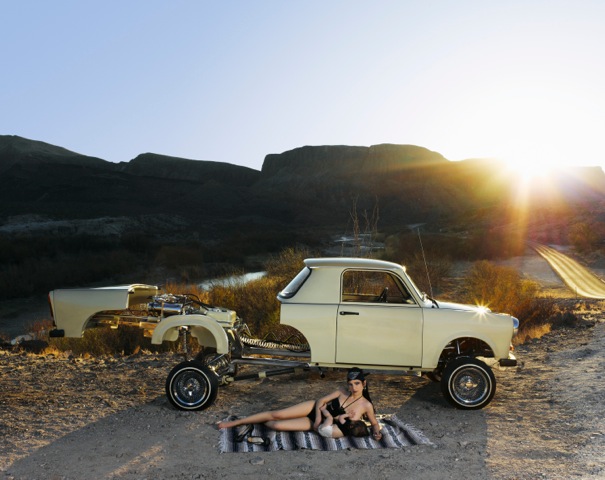
© » KADIST
Liz Cohen
The photographic work Lowrider Builder and Child is a companion piece to the video Hydroforce , which features Cohen in the late stage of her pregnancy posing atop a German car that she transformed into a lowrider in a period of ten years. While in Hydroforce we see the artist pregnant, Lowrider Builder and Child features the artist’s newborn by her side. In the image, the positioning of Cohen’s body, together with the tranquil, idyllic nature of the site in which she reclines to breastfeed her baby — with the gentle light gleaming as it bounces off the hood of her car — is a nod to classical reclining nude paintings, which invariably portray female subjects.
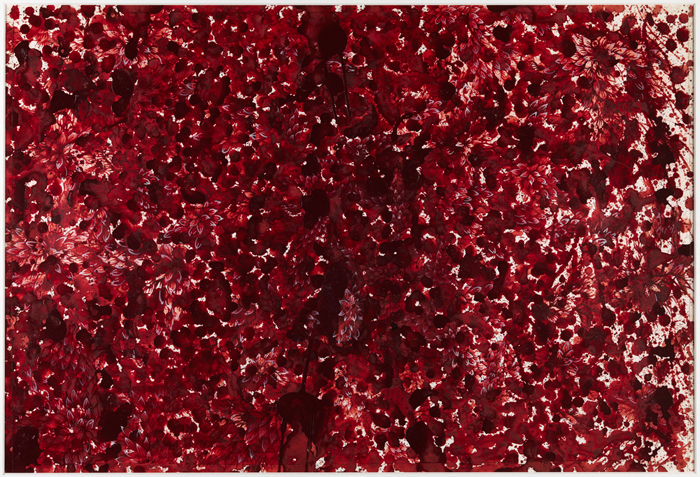
© » KADIST
Imran Qureshi
There was a tragedy in Sialkot, Punjab, in August 2010, when two adolescents were murdered by vigilantes who were apparently in connivance with the police. Struck by this blunder revealing police corruption, the started a series of paintings on paper, You who are my love and my life’s enemy too, in which he expressed his reaction to this murder. At first glance the work appears to be a splash of blood like the one in this killing, but, close up, the composition reveals itself as meticulous floral motifs typical of the art of miniature painting which the artist teaches.
Gan Chin Lee
Gan Chin Lee is a Malaysian artist of Chinese descent known across Southeast Asia for his realist paintings that painstakingly register the ethnic and religious complexities of Malaysia...
Xiaoyun Chen
- location: Hangzhou, China
- year born: 1971
- gender: male
- nationality: Chinese
- home town: Hubei Province, China
Ian Cheng
The work of Ian Cheng explores evolutionary processes, including mutation and adaptation in response to changing conditions...
Yin-Ju Chen
- year born: 2011
- gender: female
- nationality: American & Taiwanese
Chia-Wei Hsu
Embarking from myriad audio-visual narratives, Chia-Wei Hsu pursues imaginative interrogations of cultural contact and colonization in Asia, oftentimes amalgamating his primary narratives with non-human actors including technologies, animals, gods, environments, traditions, and material objects...
Angela Su
Angela Su’s practice is derived from her two divergent backgrounds–she received a degree in biochemistry in Canada before pursuing visual arts...
Chen Shaoxiong
- location: Beijing
- location: Guangzhou, China
- year born: 1962
- gender: male
- nationality: Chinese
- home town: Shantou, Guangdong Province, China
Liz Cohen
Liz Cohen is a photographer and performance artist best known for her project Bodywork , in which she transformed a German car into a lowrider while simultaneously transforming her own body, with the help of a fitness instructor, to become a bikini model at lowrider shows...
Pak Sheung Chuen
- location: Hong Kong, China
- year born: 1977
- gender: male
- nationality: Chinese
- home town: Fujian, China
Minia Biabiany
Minia Biabiany’s practice is concerned with the past and ongoing effects of colonialism, exploring the poetics of resistance embedded in everyday life practices, and translating this research into the exhibition space through careful consideration of the cultural and spiritual implications of the material she uses, and the techniques she employs...
Imran Qureshi
Pakistani artist Imran Qureshi’s practice revives 16th century Mughal miniature painting...
Park Chan-Kyong
Artist and filmmaker Park Chan-kyong was born in Seoul under the reign of Park Chung-hee, whose authoritarian rule transformed South Korea from an impoverished, war-torn country into what the artist describes as a ‘militaristic, repressive, modern state.’ The shadows of Japanese occupation and the Korean War loomed large over the period, driving the call for nationalism and productivity...
Che Onejoon
Che Onejoon started working with photography in mandatory military service as an evidence photographer for the South Korean Combat Police recording different incidents for proof...
Chen Chieh-Jen
- location: Taipei, Taiwan
- year born: 1960
- gender: male
- nationality: Chinese
- home town: Taoyuan, Taiwan
Troy Chew
Spanning painting, drawing, and sculpture, Troy Chew’s practice reflects on the legacy of the African diaspora through the lens of urban culture...
Leelee Chan
Working in sculpture, Leelee Chan’s visual vocabulary reflects her subjective experience of the extreme urbanization in Hong Kong by proposing a dialogue between concrete materiality, found in heavy industry, and poetics found in ceramics, and its cultural archaeology in millinery Chinese history...
Jesse Chun
Through video, drawing, sculpture, sound, installation, and publications, Jesse Chun’s multidisciplinary practice critically engages with the politics of language...
I-Hsuen Chen
I-Hsuen Chen started focusing on visual arts in the late 2000s after working as a professional opera and choir singer in Taiwan...
Hu Yun
- location: Shanghai, China
- year born: 1986
- gender: male
- nationality: Chinese
- home town: Shanghai, China
Vivian Suter
Vivian Suter was born in Buenos Aires but brought up in Switzerland where she trained to be an artist...
Hung-Chin Peng
There is a palpable urgency in the work of Taiwan-based Peng Hung-Chih, who uses video, sculpture, installation, and painting as means to criticize society...
Ruijun Shen
Ruijun Shen conceptualizes her painting-based practice as a form of extended meditation and a means of processing tensions between time and space in the world around us...
Shen Xin
Shen Xin’s practice examines how emotion, judgment, and ethics are produced and articulated through individual and collective subjects...
Shu Lea Cheang
Shu Lea Cheang’s practice combines artistic concerns with social issues, and is highly acclaimed as a leading figure in post-porn feminist art, becoming a crucial player that resonates with present-day subjects of queerness and trans discourse...
Chen Zhexiang
CHEN Zhexiang is a digital media artist and director of animation...
Kent Chan
As an artist, curator, and filmmaker; Kent Chan’s practice revolves around encounters with art, fiction, and cinema that form a trio of practices porous in form, content, and context...
Cao Shu
Cao Shu’s works span three-dimensional digital moving images, sound installation, and interactive games...
Shen Yuan
Shen Yuan studied Chinese painting at the Zhejiang Academy of Fine Arts as the first group of students admitted after the Cultural Revolution...
Mimian Hsu Chen
Costa Rica-based artist Mimian Hsu works with photography, documents, typography, and objects to construct site-specific installations, performances, and projects that explore intersecting cultural identities...
-
2000-2009
Chen Shaoxiong
2006After engaging primarily with video and photography for more than a decade, Chen turned to painting to explore the issue of urban change and memories—both personal and collective...
Xiaoyun Chen
2006The image of rusted nails, nuts and bolts as shrapnel sandwiched between a fried Chicken burger highlights the contrast between decadence and destruction...
Xiaoyun Chen
2006State Terrorism in the ultimate form of Pre-Raphaelite Brotherhood features a portrait of the artist wearing a zipped utilitarian jacket reminiscent of a worker’s uniform, with one arm behind his back as if forced to ingest a bundle of stick—a literal portrayal to the definition of fascism...
Ruijun Shen
2006In Seven Deadly Sins (2006), Shen utilizes abstraction to produce complex topographies of color that evoke associations with violently tumultuous landscapes...
Chen Shaoxiong
2007After engaging primarily with video and photography for more than a decade, Chen turned to painting to explore the issue of urban change and memories—both personal and collective...
Hung-Chin Peng
2008In Excerpts from the Analects of Confucius , Peng Hung-Chih explores the relationship between Confucianism and religion...
Pak Sheung Chuen
2008Pak created New York Public Library Projects (NYPLP) (2008) during a residency in New York, using public libraries as exhibition spaces and the books they house as raw materials...
-
2010-2019
Chen Chieh-Jen
2010Empire’s Borders II – Passage and Empire’s Borders II – Workers are from the three-channel film installation Empire’s Borders II – Western Enterprise, Inc...
Chen Chieh-Jen
2010Empire’s Borders II – Passage and Empire’s Borders II – Workers are from the three-channel film installation Empire’s Borders II – Western Enterprise, Inc...
Yin-Ju Chen
Drawing & Print
2011(Drawing & Print) This work includes sketches for Extrastellar Evaluations , the project she produced at Kadist...
Imran Qureshi
2011There was a tragedy in Sialkot, Punjab, in August 2010, when two adolescents were murdered by vigilantes who were apparently in connivance with the police...
Angela Su
Drawing & Print
2011(Drawing & Print) From afar, Chimeric Antibodies by Angela Su may look like scientific drawings or botanical illustrations...
Chia-Wei Hsu
2012Marshal Tie Jia (Turtle Island) explores the history of a tiny island off of the coast of Matsu in the Taiwan Strait that has been instrumental in the geopolitical relationships between China, Taiwan, and Japan...
Xiaoyun Chen
2012The lengthy titles in Chen Xiaoyun’s work often appear as colophons to his photographs that invite the viewer to a process of self realization through contemplating the distance between word and image...
Che Onejoon
2013For the last few years, Che Onejoon has been focusing on the relationships between African countries and North Korea...
Mimian Hsu Chen
2014In Hsu’s work, Colonia China (2014), the artist documents a Chinese cemetery of Costa Rica’s Limón Province, along the country’s Caribbean coast...
Xiaoyun Chen
2014The central point of Vanishing Point is the most direct physiological reaction of the body to the environment...
Chia-Wei Hsu
2016The final work in the Marshal Tie Jia series (of which Turtle Island is in the KADIST collection), Spirit Writing features the Marshal in conversation with Chia-Wei Hsu, by way of a ritual involving the Marshal’s divination chair...
I-Hsuen Chen
Drawing & Print
2016(Drawing & Print) Part of the series Still Life Analysis II: The Island , the two photographs The Objects under the Civic Boulevard and A Yellow Blanket on a Wooden Pallet feature household objects of vagrants living beneath the Taipei’s Civic Boulevard expressway...
Yin-Ju Chen
2016Through a semi-fictional approach, Extrastellar Evaluations envisions a version of history in which alien inhabitants, the Lemurians, lived among humans under the guise of various renowned conceptual and minimal artists in the 1960s (Carl Andre, Mel Bochner, and James Turrell to name a few)...
Laura Huertas Millán
2016La libertad is a “greca” film, a meander film, with no beginning nor end, weaving together fragments of daily life at the Navarro´s, counting threads and time, wondering and wandering around words as emancipation, labor, and freedom (la libertad), the word that most appeared in our conversations...
Park Chan-Kyong
2016Park Chan-Kyong’s film Citizen’s Forest draws on two works for which the artist has a particular fondness: The Lemures , an incomplete painting by Korean artist Oh Yoon, and Colossal Roots , a poem by Korean poet Kim Soo-Young...
Imran Qureshi
2017At first glance, This Day by Imran Qureshi appears to be an energetic, gestural painting reminiscent of Action Painting from the mid-20th century...
Pak Sheung Chuen
Drawing & Print
2017(Drawing & Print) The series Nightmare Wallpapers represents a shift if Chuen’s practice, allowing the artist to immerse himself in an “artistic pilgrimage of self healing” following the failure of the 2014 Umbrella Movement...
Yin-Ju Chen
2018Extrastellar Evaluations is a multimedia installation produced during Yin-Ju Chen’s residency at Kadist San Francisco in the spring of 2016...
Che Onejoon
2018Che Onejoon’s unsettling video My Utopia opens with a round table of women asking and answering the questions “Who am I? Where did I come from? Where should I go?” One of the women featured is Monique Macías, the daughter of Francisco Macías Nguema, the first Prime Minister of Equatorial Guinea...
Chia-Wei Hsu
2019Stones and Elephants by Chia-Wei Hsu derives from the Malay literary classic The Hikayat Abdullah ...
Leelee Chan
2019Blindfold Receptor (caterpillar-yellow) by Leelee Chan is inspired by the camouflaging nature of the peppered-moth caterpillar...
Minia Biabiany
2019Qui vivra verra, Qui mourra saura is an installation by Minia Biabiany composed of the plan of a house made out of strips of salt, and a “garden” made of ceramic pieces, hanging from the ceiling and on the floor, and non woven fabric...
Ana María Millán
2019Interested in role-play and videogames, Ana María Millán developed workshops with different communities in order to create characters and scenarios for her animations, often in collaboration with a choreographer...
Shu Lea Cheang
2019Reflecting upon the transformation of surveillance techniques since the panopticon to include contemporary 3-D facial recognition, AI, and the Internet, Shu Lea Cheang’s 3x3x6 – 10 cases 10 data restages the rooms of the Palazzo delle Prigioni—a Venetian prison from the sixteenth century in operation until 1922—as a high-tech surveillance space...
Angela Su
Drawing & Print
2019(Drawing & Print) In the first part of Cosmic Call by Angela Su the voiceover proposes in a neutral, documentary-like tone, a series of stories to rethink the way we usually understand, justify, or place blame for epidemiological events...
Gan Chin Lee
Drawing & Print
2019(Drawing & Print) In Studies of Chinese New Villages II Gan Chin Lee’s realism appears in the format of a fieldwork notebook; capturing present-day surroundings while unpacking their historical memory...
Gan Chin Lee
Drawing & Print
2019(Drawing & Print) In Studies of Chinese New Villages II Gan Chin Lee’s realism appears in the format of a fieldwork notebook; capturing present-day surroundings while unpacking their historical memory...
Gan Chin Lee
Drawing & Print
2019(Drawing & Print) In Studies of Chinese New Villages II Gan Chin Lee’s realism appears in the format of a fieldwork notebook; capturing present-day surroundings while unpacking their historical memory...
Gan Chin Lee
Drawing & Print
2019(Drawing & Print) In Studies of Chinese New Villages II Gan Chin Lee’s realism appears in the format of a fieldwork notebook; capturing present-day surroundings while unpacking their historical memory...
Gan Chin Lee
Drawing & Print
2019(Drawing & Print) In Studies of Chinese New Villages II Gan Chin Lee’s realism appears in the format of a fieldwork notebook; capturing present-day surroundings while unpacking their historical memory...
Angela Su
2019Produced in an interview format and as an extended chapter of Cosmic Call (2019) in the KADIST Collection, Angela Su’s True Calling by Angela Su documents the artist’s answers to a series of questions on the conception of her 2019 film that proposes speculative cosmic synchronicities for an alternative understanding of epidemics that is not built on the foundation and authority of Western medical science...
Gan Chin Lee
Drawing & Print
2019(Drawing & Print) In Studies of Chinese New Villages II Gan Chin Lee’s realism appears in the format of a fieldwork notebook; capturing present-day surroundings while unpacking their historical memory...
Gan Chin Lee
Drawing & Print
2019(Drawing & Print) In Studies of Chinese New Villages II Gan Chin Lee’s realism appears in the format of a fieldwork notebook; capturing present-day surroundings while unpacking their historical memory...
Park Chan-Kyong
2019Park Chan-Kyong’s otherworldly film Belated Bosal primarily follows two women as they navigate their way up a spectral mountain and through what appears to be a history museum or nuclear disaster bunker...
Gan Chin Lee
Drawing & Print
2019(Drawing & Print) In Studies of Chinese New Villages II Gan Chin Lee’s realism appears in the format of a fieldwork notebook; capturing present-day surroundings while unpacking their historical memory...
Gan Chin Lee
Drawing & Print
2019(Drawing & Print) In Studies of Chinese New Villages II Gan Chin Lee’s realism appears in the format of a fieldwork notebook; capturing present-day surroundings while unpacking their historical memory...
Gan Chin Lee
Drawing & Print
2019(Drawing & Print) In Studies of Chinese New Villages II Gan Chin Lee’s realism appears in the format of a fieldwork notebook; capturing present-day surroundings while unpacking their historical memory...
Gan Chin Lee
Drawing & Print
2019(Drawing & Print) In Studies of Chinese New Villages II Gan Chin Lee’s realism appears in the format of a fieldwork notebook; capturing present-day surroundings while unpacking their historical memory...
-
2020-2029
Minia Biabiany
2020Musa is a visual and textual work by Minia Biabiany and the starting point of a broader research around the sexuality of Caribbean women, the historical legacy of slavery, and the artist’s own female lineage...
Chen Zhexiang
2021In the video work Any Resemblance is Coincidental , CHEN Zhexiang mined portraits of real Asian criminals that were abandoned on the Internet...
Kent Chan
2021Heat Waves by Kent Chan examines the contexts, politics, and proliferation of the different aesthetics of heat by drawing from the aesthetics of regions defined by hot and humid climates and associated with histories of coloniality such as ‘the global south’ and the ‘developing world’...
Jesse Chun
2021O (for various skies) by Jesse Chun is a two-channel video sculpture that decentralizes American colonial narratives about the moon through “unlanguaging”—a methodology that the artist has conceptualized for unfixing language...












